Discussion: The Respiratory System Essay
The respiratory system is responsible for gaseous exchange in the body. This is the process by which respiratory gases are transported in the body. The lungs are the main organs that are responsible for the process. Gaseous exchange occurs in the lobules, which consist of pulmonary capillaries, bronchioles, and alveoli. Alveolar cells are classified into type one, the thin squamous, used in gaseous exchange, and type two, the cuboidal ones for surfactant production and serve as progenitor cells. There are four surfactants, SP-B and SP-C, for surface tension, and SP-A and SP- D are proteins used in immune and inflammatory responses (Iheanacho et al., 2020). Lung compliance determines to what extent they inflate and is controlled by the surface tension of the lungs, water content, chest wall, and elastic and collagen fibers.
Tabitha has infant respiratory distress syndrome, which results from insufficient or lack of surfactant factor that coats the inner layers of the alveoli. Its primary purpose is to keep the lungs open for breathing till the birth of the baby. Its absence or insufficiency will lead to thickening and inflammation of the alveoli, leading to the collapse of the lungs during exhalation (Dyer, 2019). This leads to compromised breathing and limited oxygen supply to the brain and body tissues.
Emphysema is an obstructive disease of the lungs caused by a lack of elasticity. This effect leads to overstretching and breaking of the alveolar walls, causing a reduction of gaseous exchange in the surface area. Alpha-1 antitrypsin deficiency is a form of emphysema that may result in lung infection as it destroys enzymes produced by the white blood cells (Argano et al., 2021). This makes the lungs to be at risk of disease and damage. Emphysema impedes airflow to the bronchi and trachea, leading to compromised breathing.
Jenny has pulmonary fibrosis, which is a restrictive condition of the lungs that increases lung stiffness. Fibrosis is scarring caused by unresolved chronic inflammatory disease (Iheanacho et al., 2020). If the typical structure of the lungs is not restored, the breathing is compromised, leading to heavy breathing. The process of fibrosis is sometimes part of the healing, but if it fails to be complete, the pulmonary vessels’ functions are impaired.
Argano, C., Scichilone, N., Natoli, G., Nobili, A., Corazza, G. R., Mannucci, P. M., Perticone, F., & Corrao, S. (2021). Pattern of comorbidities and 1-year mortality in elderly patients with COPD hospitalized in internal medicine wards: Data from the RePoSI Registry . Internal and Emergency Medicine , 16 (2), 389-400. Web.
Dyer, J. (2019). Neonatal respiratory distress syndrome: Tackling a worldwide problem. Pharmacy and Therapeutics , 44 (1), 12-15.
Iheanacho, I., Zhang, S., King, D., Rizzo, M., & Ismaila, A. S. (2020). Economic burden of chronic obstructive pulmonary disease (COPD): A systematic literature review . International Journal of Chronic Obstructive Pulmonary Disease , 15 , 439-445. Web.
- Chicago (A-D)
- Chicago (N-B)
IvyPanda. (2024, April 2). Discussion: The Respiratory System. https://ivypanda.com/essays/discussion-the-respiratory-system/
"Discussion: The Respiratory System." IvyPanda , 2 Apr. 2024, ivypanda.com/essays/discussion-the-respiratory-system/.
IvyPanda . (2024) 'Discussion: The Respiratory System'. 2 April.
IvyPanda . 2024. "Discussion: The Respiratory System." April 2, 2024. https://ivypanda.com/essays/discussion-the-respiratory-system/.
1. IvyPanda . "Discussion: The Respiratory System." April 2, 2024. https://ivypanda.com/essays/discussion-the-respiratory-system/.
Bibliography
IvyPanda . "Discussion: The Respiratory System." April 2, 2024. https://ivypanda.com/essays/discussion-the-respiratory-system/.
- Hunting in Wildlife Refuges in California
- Medicine Issues: Emphysema' Disease
- The Acts 9:36-43 Passage Interpretation
- Anatomy of the Human Chest
- The Asthma and Emphysema Analysis
- "Exhalation" and "The Great Silence" by Chiang Review
- Differentiation of Renal Progenitor Cells
- Sensory Processing Disorder (SPD)
- Emphysema: Cellular and Molecular Physiology
- Establishing Organ Systems Roles
- Disaster Preparation and Mitigation Strategies
- Homeless Vulnerable Population in North Carolina
- Spiritual and Non-Spiritual Health Care
- The Healthcare Disparities Among Latin-Americans
- "A Broken Health Care System" by Interlandi

- school Campus Bookshelves
- menu_book Bookshelves
- perm_media Learning Objects
- login Login
- how_to_reg Request Instructor Account
- hub Instructor Commons
- Download Page (PDF)
- Download Full Book (PDF)
- Periodic Table
- Physics Constants
- Scientific Calculator
- Reference & Cite
- Tools expand_more
- Readability
selected template will load here
This action is not available.


8.1: Introduction to the Respiratory System
- Last updated
- Save as PDF
- Page ID 34622
Learning Objectives
By the end of this section, you will be able to:
- List the structures of the respiratory system
- List the major functions of the respiratory system
- Outline the forces that allow for air movement into and out of the lungs
- Outline the process of gas exchange
- Summarize the process of oxygen and carbon dioxide transport within the respiratory system
- Create a flow chart illustrating how respiration is controlled
- Discuss how the respiratory system responds to exercise
- Describe the development of the respiratory system in the embryo

Hold your breath. Really! See how long you can hold your breath as you continue reading. . . . How long can you do it? Chances are you are feeling uncomfortable already. A typical human cannot survive without breathing for more than 3 minutes, and even if you wanted to hold your breath longer, your autonomic nervous system would take control. This is because every cell in the body needs to run the oxidative stages of cellular respiration, the process by which energy is produced in the form of adenosine triphosphate (ATP). For oxidative phosphorylation to occur, oxygen is used as a reactant and carbon dioxide is released as a waste product.
You may be surprised to learn that although oxygen is a critical need for cells, it is actually the accumulation of carbon dioxide that primarily drives your need to breathe. Carbon dioxide is exhaled and oxygen is inhaled through the respiratory system, which includes muscles to move air into and out of the lungs, passageways through which air moves, and microscopic gas exchange surfaces covered by capillaries. The circulatory system transports gases from the lungs to tissues throughout the body and vice versa. A variety of diseases can affect the respiratory system, such as asthma, emphysema, chronic obstruction pulmonary disorder (COPD), and lung cancer. All of these conditions affect the gas exchange process and result in labored breathing and other difficulties.
Contributors and Attributions
- Anatomy & Physiology. Provided by : OpenStax CNX. Located at : http://cnx.org/contents/[email protected] . License : CC BY: Attribution . License Terms : Download for free at http://cnx.org/contents/[email protected]

ESSAY SAUCE
FOR STUDENTS : ALL THE INGREDIENTS OF A GOOD ESSAY
Essay: The respiratory system
Essay details and download:.
- Subject area(s): Health essays
- Reading time: 2 minutes
- Price: Free download
- Published: 17 October 2015*
- File format: Text
- Words: 594 (approx)
- Number of pages: 3 (approx)
Text preview of this essay:
This page of the essay has 594 words. Download the full version above.
The human body is organized into numerous complex systems that interact with each other in order for it to function and sustain life. One of those vital systems is the respiratory system. The main function of the respiratory system is to consume oxygen and expel carbon dioxide, otherwise known as breathing, or ventilation. Oxygen is diffused into the bloodstream and carried throughout the body to tissues and cells to drive necessary reaction in the mitochondria in which carbon dioxide is a waste gas product. There are other various functions of the respiratory system such as acid-base regulation in the blood, vocalization through the mouth, pathogenic defense in the airways and the activation of plasma proteins. The respiratory system consists of many organs that allow for it to function effectively and efficiently; the organs are divided into three sections: the upper airway, respiratory tract, and the thoracic cavity. The upper airway consists of the nasal and oral cavity and the pharynx. The respiratory tract consists of the larynx, trachea, bronchi, and alveoli. The thoracic cavity consists of the lungs and the diaphragm. These organs function together to enable us to sustain life through breathing. As previously stated, breathing is the uptake of oxygen for cellular processes and the expulsion of carbon dioxide waste. Breathing is divided into two separate processes: inspiration and expiration. During inspiration, the diaphragm contracts, decreases in size and moves downward to allow the lungs to expand and increase volume. The air from outside the body is inhaled through the nasal or oral cavity and is filtered by cilia, or small hairs that line the cavity, to prevent foreign particles from entering air pathway. The inhaled air enters and passes through the pharynx, or throat, towards the larynx. The air then passes through the larynx and enters the trachea, or windpipe, which then splits into the left and right bronchial tubes that lead into each lung. The bronchial tubes branch off into smaller tubes called bronchioles. Located at the end of each bronchiole are small sacs called alveoli which is the location where oxygen from the inhaled air diffuses into the bloodstream through the respiratory membrane. During expiration, the diaphragm relaxes, increases in size and moves upward to compress the lungs and decrease in volume. Carbon dioxide from the bloodstream is diffused through the respiratory membrane into the alveoli and forced out the same way the air entered the body. The process of ventilation is driven behind the concept of Boyle’s law which states that the pressure is inversely proportional to the volume of a given quantity of gas. Essentially, the respiratory system works by producing pressure gradients between the atmospheric pressure and the intra-alveolar pressure, the pressure inside the alveoli. During inspiration, the diaphragm contracts, increasing the volume of the lungs which decreases the intra-alveolar pressure below atmospheric pressure causing air to move into the body. Expiration is the opposite, the diaphragm relaxes and enlarges and decreases the volume of the lungs which increases the intra-alveolar pressure above atmospheric pressure causing air to move out of the body. The respiratory system’s primary function is to provide the body with oxygen through inspiration and expel the carbon dioxide gas through expiration. The organs that constitute the respiratory system create a pressure gradient in which the breathing process is solely based upon. Sometimes the pressure gradient can be disrupted by a chronic lung disease called asthma. Asthma is a chronic lung disease in which the muscles surrounding airways become inflamed and narrowed resulting in the loss of airflow into the lungs.
...(download the rest of the essay above)
About this essay:
If you use part of this page in your own work, you need to provide a citation, as follows:
Essay Sauce, The respiratory system . Available from:<https://www.essaysauce.com/health-essays/essay-the-respiratory-system/> [Accessed 07-04-24].
These Health essays have been submitted to us by students in order to help you with your studies.
* This essay may have been previously published on Essay.uk.com at an earlier date.
Essay Categories:
- Accounting essays
- Architecture essays
- Business essays
- Computer science essays
- Criminology essays
- Economics essays
- Education essays
- Engineering essays
- English language essays
- Environmental studies essays
- Essay examples
- Finance essays
- Geography essays
- Health essays
- History essays
- Hospitality and tourism essays
- Human rights essays
- Information technology essays
- International relations
- Leadership essays
- Linguistics essays
- Literature essays
- Management essays
- Marketing essays
- Mathematics essays
- Media essays
- Medicine essays
- Military essays
- Miscellaneous essays
- Music Essays
- Nursing essays
- Philosophy essays
- Photography and arts essays
- Politics essays
- Project management essays
- Psychology essays
- Religious studies and theology essays
- Sample essays
- Science essays
- Social work essays
- Sociology essays
- Sports essays
- Types of essay
- Zoology essays

- school Campus Bookshelves
- menu_book Bookshelves
- perm_media Learning Objects
- login Login
- how_to_reg Request Instructor Account
- hub Instructor Commons
- Download Page (PDF)
- Download Full Book (PDF)
- Periodic Table
- Physics Constants
- Scientific Calculator
- Reference & Cite
- Tools expand_more
- Readability
selected template will load here
This action is not available.

14.2: Organs and Structures of the Respiratory System
- Last updated
- Save as PDF
- Page ID 57551
Learning Objectives
- List the structures that make up the respiratory system
- Describe how the respiratory system processes oxygen and CO 2
- Compare and contrast the functions of upper respiratory tract with the lower respiratory tract
The major organs of the respiratory system function primarily to provide oxygen to body tissues for cellular respiration, remove the waste product carbon dioxide, and help to maintain acid-base balance. Portions of the respiratory system are also used for non-vital functions, such as sensing odors, speech production, and for straining, such as during childbirth or coughing (Figure \(\PageIndex{1}\)).
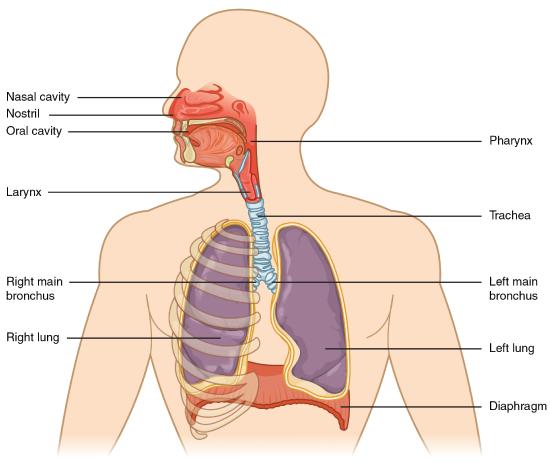
Functionally, the respiratory system can be divided into a conducting zone and a respiratory zone. The conducting zone of the respiratory system includes the organs and structures not directly involved in gas exchange. The gas exchange occurs in the respiratory zone .
Conducting Zone
The major functions of the conducting zone are to provide a route for incoming and outgoing air, remove debris and pathogens from the incoming air, and warm and humidify the incoming air. Several structures within the conducting zone perform other functions as well. The epithelium of the nasal passages, for example, is essential to sensing odors, and the bronchial epithelium that lines the lungs can metabolize some airborne carcinogens.
The Nose and Its Adjacent Structures
The major entrance and exit for the respiratory system is through the nose. When discussing the nose, it is helpful to divide it into two major sections: the external nose, and the nasal cavity or internal nose.
The external nose consists of the surface and skeletal structures that result in the outward appearance of the nose and contribute to its numerous functions (Figure \(\PageIndex{2}\)). The root is the region of the nose located between the eyebrows. The bridge is the part of the nose that connects the root to the rest of the nose. The dorsum nasi is the length of the nose. The apex is the tip of the nose. On either side of the apex, the nostrils are formed by the alae (singular = ala). An ala is a cartilaginous structure that forms the lateral side of each naris (plural = nares), or nostril opening. The philtrum is the concave surface that connects the apex of the nose to the upper lip.
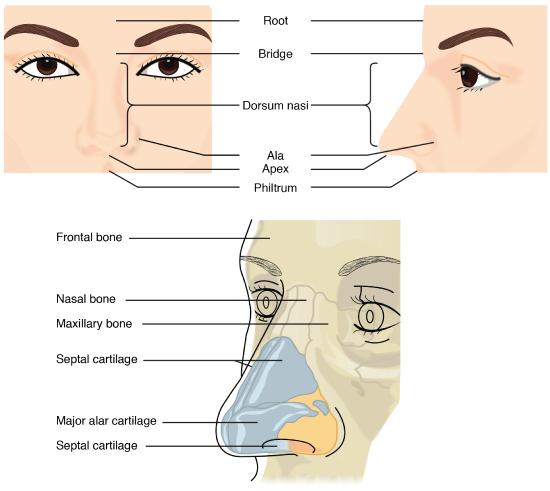
Underneath the thin skin of the nose are its skeletal features (see Figure \(\PageIndex{2}\), lower illustration). While the root and bridge of the nose consist of bone, the protruding portion of the nose is composed of cartilage. As a result, when looking at a skull, the nose is missing. The nasal bone is one of a pair of bones that lies under the root and bridge of the nose. The nasal bone articulates superiorly with the frontal bone and laterally with the maxillary bones. Septal cartilage is flexible hyaline cartilage connected to the nasal bone, forming the dorsum nasi. The alar cartilage consists of the apex of the nose; it surrounds the naris.
The nares open into the nasal cavity, which is separated into left and right sections by the nasal septum (Figure \(\PageIndex{3}\)). The nasal septum is formed anteriorly by a portion of the septal cartilage (the flexible portion you can touch with your fingers) and posteriorly by the perpendicular plate of the ethmoid bone (a cranial bone located just posterior to the nasal bones) and the thin vomer bones (whose name refers to its plough shape). Each lateral wall of the nasal cavity has three bony projections, called the superior, middle, and inferior nasal conchae. The inferior conchae are separate bones, whereas the superior and middle conchae are portions of the ethmoid bone. Conchae serve to increase the surface area of the nasal cavity and to disrupt the flow of air as it enters the nose, causing air to bounce along the epithelium, where it is cleaned and warmed. The conchae and meatuses also conserve water and prevent dehydration of the nasal epithelium by trapping water during exhalation. The floor of the nasal cavity is composed of the palate. The hard palate at the anterior region of the nasal cavity is composed of bone. The soft palate at the posterior portion of the nasal cavity consists of muscle tissue. Air exits the nasal cavities via the internal nares and moves into the pharynx.
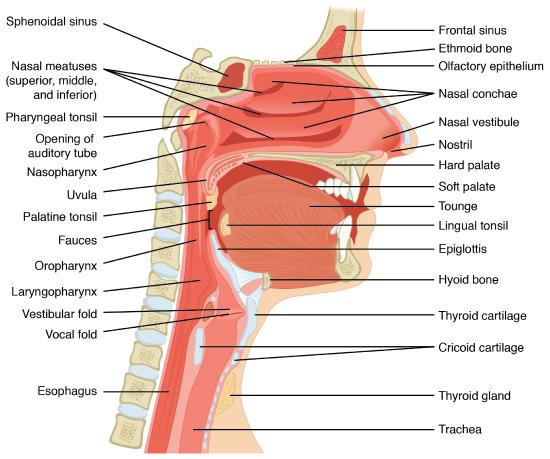
Several bones that help form the walls of the nasal cavity have air-containing spaces called the paranasal sinuses, which serve to warm and humidify incoming air. Sinuses are lined with a mucosa. Each paranasal sinus is named for its associated bone: frontal sinus, maxillary sinus, sphenoidal sinus, and ethmoidal sinus. The sinuses produce mucus and lighten the weight of the skull.
The nares and anterior portion of the nasal cavities are lined with mucous membranes, containing sebaceous glands and hair follicles that serve to prevent the passage of large debris, such as dirt, through the nasal cavity. An olfactory epithelium used to detect odors is found deeper in the nasal cavity.
The conchae, meatuses, and paranasal sinuses are lined by respiratory epithelium composed of pseudostratified ciliated columnar epithelium (Figure \(\PageIndex{4}\)). The epithelium contains goblet cells, one of the specialized, columnar epithelial cells that produce mucus to trap debris. The cilia of the respiratory epithelium help remove the mucus and debris from the nasal cavity with a constant beating motion, sweeping materials towards the throat to be swallowed. Interestingly, cold air slows the movement of the cilia, resulting in accumulation of mucus that may in turn lead to a runny nose during cold weather. This moist epithelium functions to warm and humidify incoming air. Capillaries located just beneath the nasal epithelium warm the air by convection. Serous and mucus-producing cells also secrete the lysozyme enzyme and proteins called defensins, which have antibacterial properties. Immune cells that patrol the connective tissue deep to the respiratory epithelium provide additional protection.
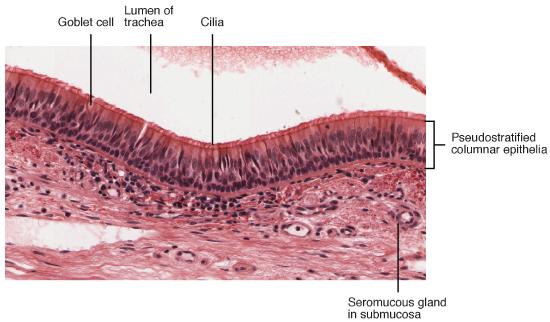
The pharynx is a tube formed by skeletal muscle and lined by mucous membrane that is continuous with that of the nasal cavities (see Figure \(\PageIndex{3}\)). The pharynx is divided into three major regions: the nasopharynx, the oropharynx, and the laryngopharynx (Figure \(\PageIndex{5}\)).
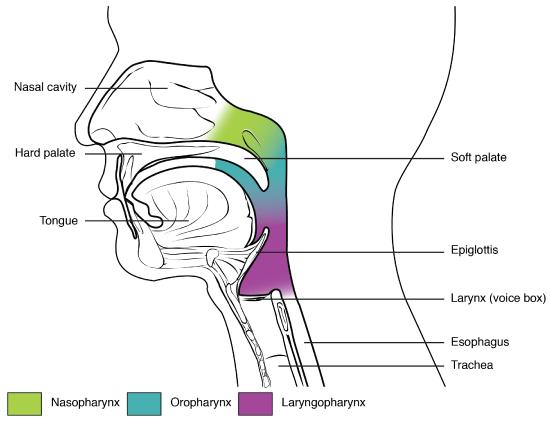
The nasopharynx is flanked by the conchae of the nasal cavity, and it serves only as an airway. At the top of the nasopharynx are the pharyngeal tonsils. A pharyngeal tonsil , also called an adenoid, is an aggregate of lymphoid reticular tissue similar to a lymph node that lies at the superior portion of the nasopharynx. The function of the pharyngeal tonsil is not well understood, but it contains a rich supply of lymphocytes and is covered with ciliated epithelium that traps and destroys invading pathogens that enter during inhalation. The pharyngeal tonsils are large in children, but interestingly, tend to regress with age and may even disappear. The uvula is a small bulbous, teardrop-shaped structure located at the apex of the soft palate. Both the uvula and soft palate move like a pendulum during swallowing, swinging upward to close off the nasopharynx to prevent ingested materials from entering the nasal cavity. In addition, auditory (Eustachian) tubes that connect to each middle ear cavity open into the nasopharynx. This connection is why colds often lead to ear infections.
The oropharynx is a passageway for both air and food. The oropharynx is bordered superiorly by the nasopharynx and anteriorly by the oral cavity. The fauces is the opening at the connection between the oral cavity and the oropharynx. As the nasopharynx becomes the oropharynx, the epithelium changes from pseudostratified ciliated columnar epithelium to stratified squamous epithelium. The oropharynx contains two distinct sets of tonsils, the palatine and lingual tonsils. A palatine tonsil is one of a pair of structures located laterally in the oropharynx in the area of the fauces. The lingual tonsil is located at the base of the tongue. Similar to the pharyngeal tonsil, the palatine and lingual tonsils are composed of lymphoid tissue, and trap and destroy pathogens entering the body through the oral or nasal cavities.
The laryngopharynx is inferior to the oropharynx and posterior to the larynx. It continues the route for ingested material and air until its inferior end, where the digestive and respiratory systems diverge. The stratified squamous epithelium of the oropharynx is continuous with the laryngopharynx. Anteriorly, the laryngopharynx opens into the larynx, whereas posteriorly, it enters the esophagus.
The larynx is a cartilaginous structure inferior to the laryngopharynx that connects the pharynx to the trachea and helps regulate the volume of air that enters and leaves the lungs (Figure \(\PageIndex{6}\)). The structure of the larynx is formed by several pieces of cartilage. Three large cartilage pieces—the thyroid cartilage (anterior), epiglottis (superior), and cricoid cartilage (inferior)—form the major structure of the larynx. The thyroid cartilage is the largest piece of cartilage that makes up the larynx. The thyroid cartilage consists of the laryngeal prominence , or “Adam’s apple,” which tends to be more prominent in males. The thick cricoid cartilage forms a ring, with a wide posterior region and a thinner anterior region. Three smaller, paired cartilages—the arytenoids, corniculates, and cuneiforms—attach to the epiglottis and the vocal cords and muscle that help move the vocal cords to produce speech.
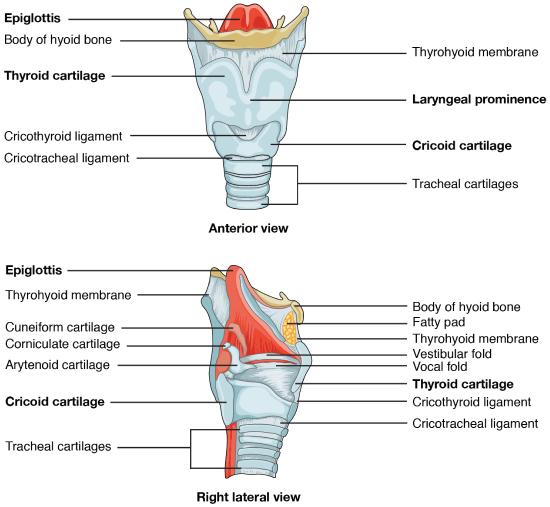
The epiglottis , attached to the thyroid cartilage, is a very flexible piece of elastic cartilage that covers the opening of the trachea (see Figure \(\PageIndex{3}\)). When in the “closed” position, the unattached end of the epiglottis rests on the glottis. The glottis is composed of the vestibular folds, the true vocal cords, and the space between these folds (Figure \(\PageIndex{7}\)). A vestibular fold , or false vocal cord, is one of a pair of folded sections of mucous membrane. A true vocal cord is one of the white, membranous folds attached by muscle to the thyroid and arytenoid cartilages of the larynx on their outer edges. The inner edges of the true vocal cords are free, allowing oscillation to produce sound. The size of the membranous folds of the true vocal cords differs between individuals, producing voices with different pitch ranges. Folds in males tend to be larger than those in females, which create a deeper voice. The act of swallowing causes the pharynx and larynx to lift upward, allowing the pharynx to expand and the epiglottis of the larynx to swing downward, closing the opening to the trachea. These movements produce a larger area for food to pass through, while preventing food and beverages from entering the trachea.

Continuous with the laryngopharynx, the superior portion of the larynx is lined with stratified squamous epithelium, transitioning into pseudostratified ciliated columnar epithelium that contains goblet cells. Similar to the nasal cavity and nasopharynx, this specialized epithelium produces mucus to trap debris and pathogens as they enter the trachea. The cilia beat the mucus upward towards the laryngopharynx, where it can be swallowed down the esophagus.
The trachea (windpipe) extends from the larynx toward the lungs (Figure \(\PageIndex{8}\).a). The trachea is formed by 16 to 20 stacked, C-shaped pieces of hyaline cartilage that are connected by dense connective tissue. The trachealis muscle and elastic connective tissue together form the fibroelastic membrane , a flexible membrane that closes the posterior surface of the trachea, connecting the C-shaped cartilages. The fibroelastic membrane allows the trachea to stretch and expand slightly during inhalation and exhalation, whereas the rings of cartilage provide structural support and prevent the trachea from collapsing. In addition, the trachealis muscle can be contracted to force air through the trachea during exhalation. The trachea is lined with pseudostratified ciliated columnar epithelium, which is continuous with the larynx. The esophagus borders the trachea posteriorly.
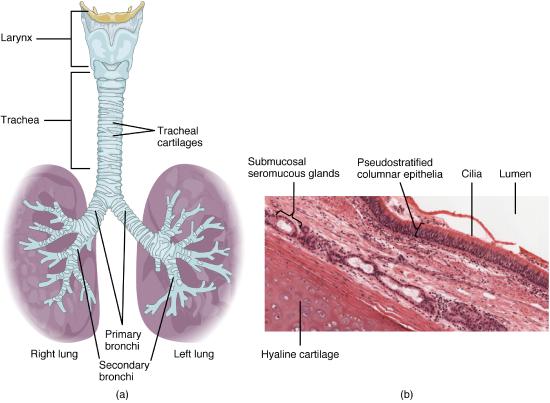
Bronchial Tree
The trachea branches into the right and left primary bronchi at the carina. These bronchi are also lined by pseudostratified ciliated columnar epithelium containing mucus-producing goblet cells (Figure \(\PageIndex{8}\).b). The carina is a raised structure that contains specialized nervous tissue that induces violent coughing if a foreign body, such as food, is present. Rings of cartilage, similar to those of the trachea, support the structure of the bronchi and prevent their collapse. The primary bronchi enter the lungs at the hilum, a concave region where blood vessels, lymphatic vessels, and nerves also enter the lungs. The bronchi continue to branch into bronchial a tree. A bronchial tree (or respiratory tree) is the collective term used for these multiple-branched bronchi. The main function of the bronchi, like other conducting zone structures, is to provide a passageway for air to move into and out of each lung. In addition, the mucous membrane traps debris and pathogens.
A bronchiole branches from the tertiary bronchi. Bronchioles, which are about 1 mm in diameter, further branch until they become the tiny terminal bronchioles, which lead to the structures of gas exchange. There are more than 1000 terminal bronchioles in each lung. The muscular walls of the bronchioles do not contain cartilage like those of the bronchi. This muscular wall can change the size of the tubing to increase or decrease airflow through the tube.
Respiratory Zone
In contrast to the conducting zone, the respiratory zone includes structures that are directly involved in gas exchange. The respiratory zone begins where the terminal bronchioles join a respiratory bronchiole , the smallest type of bronchiole (Figure \(\PageIndex{9}\)), which then leads to an alveolar duct, opening into a cluster of alveoli.
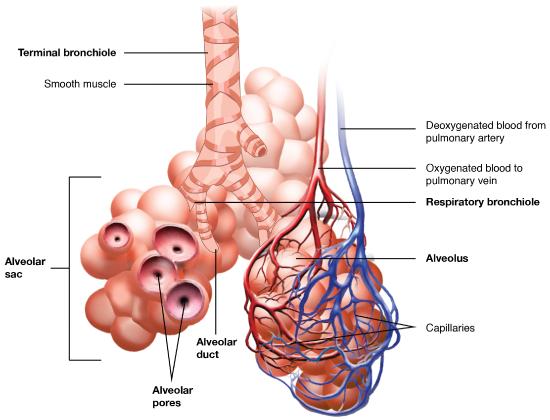
An alveolar duct is a tube composed of smooth muscle and connective tissue, which opens into a cluster of alveoli. An alveolus is one of the many small, grape-like sacs that are attached to the alveolar ducts.
An alveolar sac is a cluster of many individual alveoli that are responsible for gas exchange. An alveolus is approximately 200 μm in diameter with elastic walls that allow the alveolus to stretch during air intake, which greatly increases the surface area available for gas exchange. Alveoli are connected to their neighbors by alveolar pores , which help maintain equal air pressure throughout the alveoli and lung (Figure \(\PageIndex{10}\)).
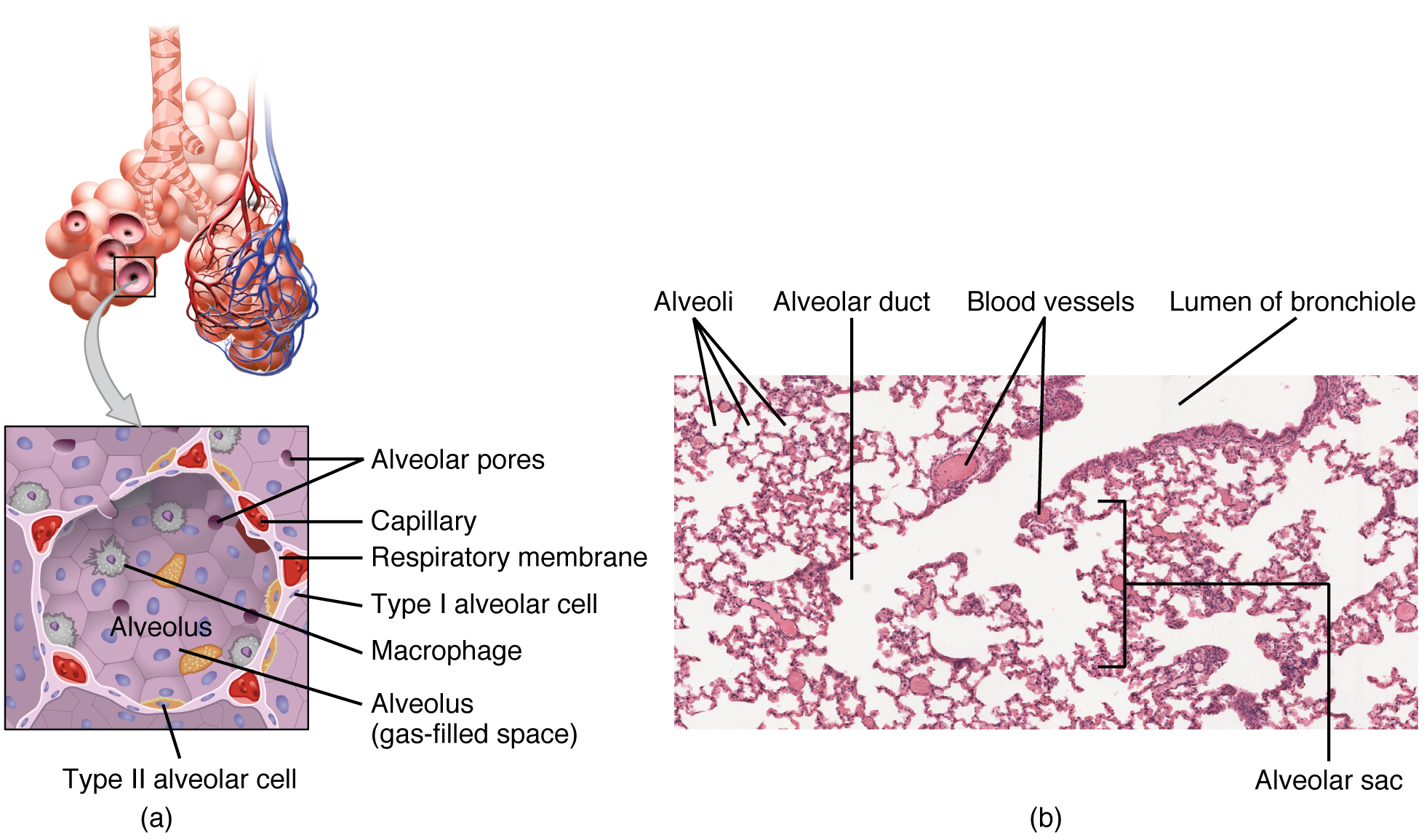
The alveolar wall consists of three major cell types: type I alveolar cells, type II alveolar cells, and alveolar macrophages. A type I alveolar cell is a squamous epithelial cell of the alveoli, which constitute up to 97 percent of the alveolar surface area. These cells are about 25 nm thick and are highly permeable to gases. A type II alveolar cell is interspersed among the type I cells and secretes pulmonary surfactant , a substance composed of phospholipids and proteins that reduces the surface tension of the alveoli. Roaming around the alveolar wall is the alveolar macrophage , a phagocytic cell of the immune system that removes debris and pathogens that have reached the alveoli.
The simple squamous epithelium formed by type I alveolar cells is attached to a thin, elastic basement membrane. This epithelium is extremely thin and borders the endothelial membrane of capillaries. Taken together, the alveoli and capillary membranes form a respiratory membrane that is approximately 0.5 mm thick. The respiratory membrane allows gases to cross by simple diffusion, allowing oxygen to be picked up by the blood for transport and CO 2 to be released into the air of the alveoli.

Diseases of the Respiratory System: Asthma
Asthma is common condition that affects the lungs in both adults and children. Approximately 8.2 percent of adults (18.7 million) and 9.4 percent of children (7 million) in the United States suffer from asthma. In addition, asthma is the most frequent cause of hospitalization in children.
Asthma is a chronic disease characterized by inflammation and edema of the airway, and bronchospasms (that is, constriction of the bronchioles), which can inhibit air from entering the lungs. In addition, excessive mucus secretion can occur, which further contributes to airway occlusion (Figure \(\PageIndex{11}\)). Cells of the immune system, such as eosinophils and mononuclear cells, may also be involved in infiltrating the walls of the bronchi and bronchioles.
Bronchospasms occur periodically and lead to an “asthma attack.” An attack may be triggered by environmental factors such as dust, pollen, pet hair, or dander, changes in the weather, mold, tobacco smoke, and respiratory infections, or by exercise and stress.
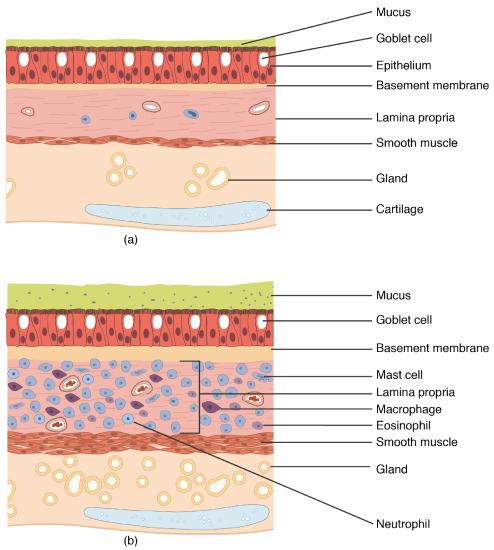
Symptoms of an asthma attack involve coughing, shortness of breath, wheezing, and tightness of the chest. Symptoms of a severe asthma attack that requires immediate medical attention would include difficulty breathing that results in blue (cyanotic) lips or face, confusion, drowsiness, a rapid pulse, sweating, and severe anxiety. The severity of the condition, frequency of attacks, and identified triggers influence the type of medication that an individual may require. Longer-term treatments are used for those with more severe asthma. Short-term, fast-acting drugs that are used to treat an asthma attack are typically administered via an inhaler. For young children or individuals who have difficulty using an inhaler, asthma medications can be administered via a nebulizer.
In many cases, the underlying cause of the condition is unknown. However, recent research has demonstrated that certain viruses, such as human rhinovirus C (HRVC), and the bacteria Mycoplasma pneumoniae and Chlamydia pneumoniae that are contracted in infancy or early childhood, may contribute to the development of many cases of asthma.
Chapter Review
The respiratory system is responsible for obtaining oxygen and getting rid of carbon dioxide, and aiding in speech production and in sensing odors. From a functional perspective, the respiratory system can be divided into two major areas: the conducting zone and the respiratory zone. The conducting zone consists of all of the structures that provide passageways for air to travel into and out of the lungs: the nasal cavity, pharynx, trachea, bronchi, and most bronchioles. The nasal passages contain the conchae and meatuses that expand the surface area of the cavity, which helps to warm and humidify incoming air, while removing debris and pathogens. The pharynx is composed of three major sections: the nasopharynx, which is continuous with the nasal cavity; the oropharynx, which borders the nasopharynx and the oral cavity; and the laryngopharynx, which borders the oropharynx, trachea, and esophagus. The respiratory zone includes the structures of the lung that are directly involved in gas exchange: the terminal bronchioles and alveoli.
The lining of the conducting zone is composed mostly of pseudostratified ciliated columnar epithelium with goblet cells. The mucus traps pathogens and debris, whereas beating cilia move the mucus superiorly toward the throat, where it is swallowed. As the bronchioles become smaller and smaller, and nearer the alveoli, the epithelium thins and is simple squamous epithelium in the alveoli. The endothelium of the surrounding capillaries, together with the alveolar epithelium, forms the respiratory membrane. This is a blood-air barrier through which gas exchange occurs by simple diffusion.
Essay Questions
Q. What happens during an asthma attack. What are the three changes that occur inside the airways during an asthma attack?
A. Inflammation and the production of a thick mucus; constriction of the airway muscles, or bronchospasm; and an increased sensitivity to allergens.
Review Questions
Q. Which of the following anatomical structures is not part of the conducting zone?
B. nasal cavity
Q. What is the function of the conchae in the nasal cavity?
A. increase surface area
B. exchange gases
C. maintain surface tension
D. maintain air pressure
Q. The fauces connects which of the following structures to the oropharynx?
A. nasopharynx
B. laryngopharynx
C. nasal cavity
D. oral cavity
Q. Which of the following are structural features of the trachea?
A. C-shaped cartilage
B. smooth muscle fibers
D. all of the above
Q. Which of the following structures is not part of the bronchial tree?
C. terminal bronchioles
D. respiratory bronchioles
Q. What is the role of alveolar macrophages?
A. to secrete pulmonary surfactant
B. to secrete antimicrobial proteins
C. to remove pathogens and debris
D. to facilitate gas exchange
Critical Thinking Questions
Q. Describe the three regions of the pharynx and their functions.
A. The pharynx has three major regions. The first region is the nasopharynx, which is connected to the posterior nasal cavity and functions as an airway. The second region is the oropharynx, which is continuous with the nasopharynx and is connected to the oral cavity at the fauces. The laryngopharynx is connected to the oropharynx and the esophagus and trachea. Both the oropharynx and laryngopharynx are passageways for air and food and drink.
Q. If a person sustains an injury to the epiglottis, what would be the physiological result?
A. The epiglottis is a region of the larynx that is important during the swallowing of food or drink. As a person swallows, the pharynx moves upward and the epiglottis closes over the trachea, preventing food or drink from entering the trachea. If a person’s epiglottis were injured, this mechanism would be impaired. As a result, the person may have problems with food or drink entering the trachea, and possibly, the lungs. Over time, this may cause infections such as pneumonia to set in.
Q. Compare and contrast the conducting and respiratory zones.
A. The conducting zone of the respiratory system includes the organs and structures that are not directly involved in gas exchange, but perform other duties such as providing a passageway for air, trapping and removing debris and pathogens, and warming and humidifying incoming air. Such structures include the nasal cavity, pharynx, larynx, trachea, and most of the bronchial tree. The respiratory zone includes all the organs and structures that are directly involved in gas exchange, including the respiratory bronchioles, alveolar ducts, and alveoli.
Bizzintino J, Lee WM, Laing IA, Vang F, Pappas T, Zhang G, Martin AC, Khoo SK, Cox DW, Geelhoed GC, et al. Association between human rhinovirus C and severity of acute asthma in children. Eur Respir J [Internet]. 2010 [cited 2013 Mar 22]; 37(5):1037–1042.
Kumar V, Ramzi S, Robbins SL. Robbins Basic Pathology. 7th ed. Philadelphia (PA): Elsevier Ltd; 2005.
Martin RJ, Kraft M, Chu HW, Berns, EA, Cassell GH. A link between chronic asthma and chronic infection. J Allergy Clin Immunol [Internet]. 2001 [cited 2013 Mar 22]; 107(4):595-601.
Contributors and Attributions
OpenStax Anatomy & Physiology (CC BY 4.0). Access for free at https://openstax.org/books/anatomy-and-physiology
Home — Essay Samples — Nursing & Health — Respiratory System — The Process of Respiration
The Process of Respiration
- Categories: Respiratory System
About this sample

Words: 1389 |
Published: Mar 1, 2019
Words: 1389 | Pages: 3 | 7 min read
Works Cited
- Hearing and Speech Science. (2017). Respiratory Physiology: Neural and Chemical Control of Respiration. Plural Publishing.
- Seikel, J. A., Drumright, D. G., & King, D. W. (2015). Anatomy & Physiology for Speech, Language, and Hearing (5th ed.). Delmar Cengage Learning.
- SOPHIA Learning. (2016). The Upper Respiratory Tract. Retrieved from https://www.sophia.org/tutorials/the-upper-respiratory-tract
- Berne, R. M., & Levy, M. N. (2017). Physiology (7th ed.). Elsevier.
- West, J. B. (2016). Respiratory Physiology: The Essentials (10th ed.). Wolters Kluwer.
- Khardori, N. (2019). Physiology, Respiration. In StatPearls [Internet]. StatPearls Publishing.
- Santrock, J. W. (2017). Life-Span Development (16th ed.). McGraw-Hill Education.
- West, J. B. (2020). Pulmonary Physiology and Pathophysiology: An Integrated, Case-Based Approach (3rd ed.). CRC Press.
- Widdicombe, J. (2016). Airway Receptors. In Comprehensive Physiology. John Wiley & Sons, Inc.
- Zaporozhanov, V. (2017). Physiology of respiration. In Basics of Anesthesia (2nd ed.). Springer.

Cite this Essay
Let us write you an essay from scratch
- 450+ experts on 30 subjects ready to help
- Custom essay delivered in as few as 3 hours
Get high-quality help

Verified writer
- Expert in: Nursing & Health

+ 120 experts online
By clicking “Check Writers’ Offers”, you agree to our terms of service and privacy policy . We’ll occasionally send you promo and account related email
No need to pay just yet!
Related Essays
2 pages / 858 words
2 pages / 774 words
2 pages / 1178 words
1 pages / 668 words
Remember! This is just a sample.
You can get your custom paper by one of our expert writers.
121 writers online
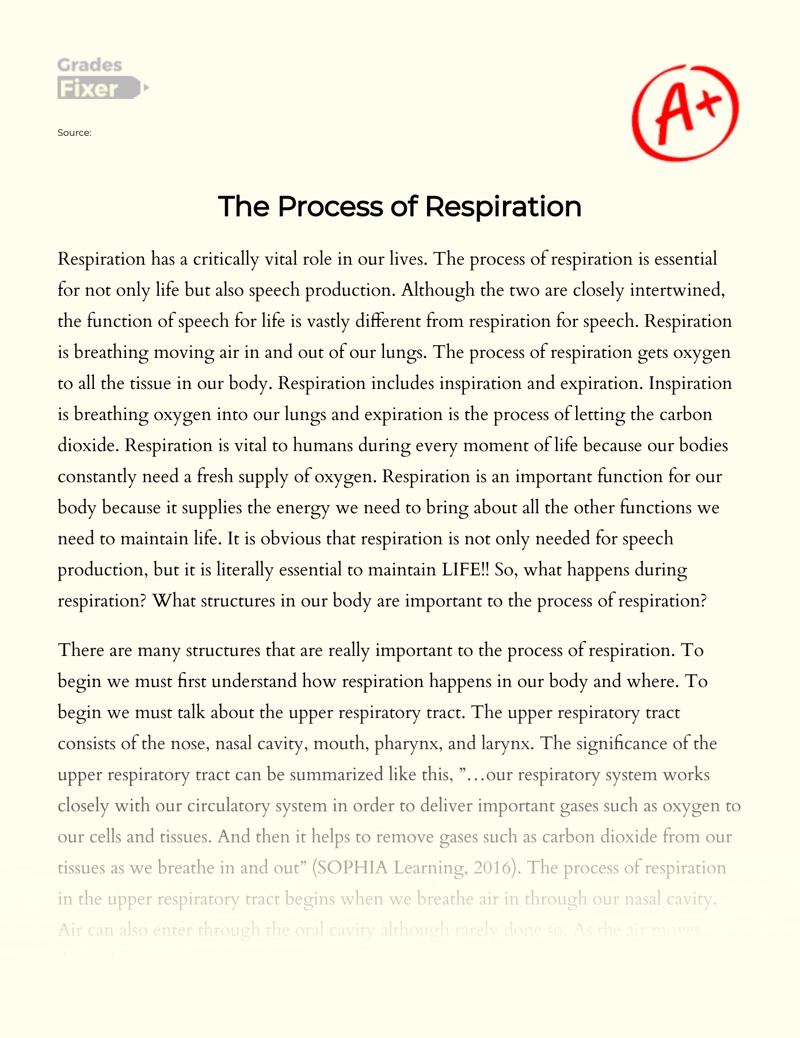
Still can’t find what you need?
Browse our vast selection of original essay samples, each expertly formatted and styled
Related Essays on Respiratory System
Oxygen is inhaled into alveoli and is passed into the capillaries and carbon dioxide is passed from the capillaries into the alveoli to be exhaled. The second step is called the internal respiration where the exchange of gases [...]
Cystic fibrosis (CF) is a genetic, recessive disorder which affects the lungs and the liver. CF develops when there is a mutation in the gene because it's autosomal recessive it means you would have inherited two copies of the [...]
Our body is made up of different systems. All of these systems collaborate together to make our human body function properly. Without all of these we wouldn’t be able to go through life normally. If you take just one away, the [...]
Hemostasis is the process that occurs when a blood vessel ruptures and large amounts of plasma and formed elements may escape (Bostwick and Wingerd, 2013). It can be divided into primary and secondary hemostasis. Primary [...]
Throughout history, the discovery of anatomy through the process of dissection has always elicited curiosity in numerous scholars scattered through the empires of the world. Of interest is how dissection was incorporated in the [...]
Abstract This paper includes the studies of techniques used to prevent, treat and nutritional or surgical therapies used for Coronary artery disease. This paper also outlines some of the causes and possible threats of having [...]
Related Topics
By clicking “Send”, you agree to our Terms of service and Privacy statement . We will occasionally send you account related emails.
Where do you want us to send this sample?
By clicking “Continue”, you agree to our terms of service and privacy policy.
Be careful. This essay is not unique
This essay was donated by a student and is likely to have been used and submitted before
Download this Sample
Free samples may contain mistakes and not unique parts
Sorry, we could not paraphrase this essay. Our professional writers can rewrite it and get you a unique paper.
Please check your inbox.
We can write you a custom essay that will follow your exact instructions and meet the deadlines. Let's fix your grades together!
Get Your Personalized Essay in 3 Hours or Less!
We use cookies to personalyze your web-site experience. By continuing we’ll assume you board with our cookie policy .
- Instructions Followed To The Letter
- Deadlines Met At Every Stage
- Unique And Plagiarism Free

IMAGES
VIDEO
COMMENTS
Get original essay. The major organs that make up the respiratory system consist of the three major parts: the airway, the lungs, and the muscles of respiration. Within those three major parts, there are organs that aid and pave the way for a healthy respiratory system. The airway, which includes the nose (Nasal cavity), mouth (Oral cavity ...
The respiratory tract conveys air from the mouth and nose to the lungs, where oxygen and carbon dioxide are exchanged between the alveoli and the capillaries. Sagittal view of the human nasal cavity. The human gas-exchanging organ, the lung, is located in the thorax, where its delicate tissues are protected by the bony and muscular thoracic cage.
The respiratory system is the network of organs and tissues that help you breathe. It includes your airways, lungs and blood vessels. The muscles that power your lungs are also part of the respiratory system. These parts work together to move oxygen throughout the body and clean out waste gases like carbon dioxide. Advertisement.
Updated: Apr 2nd, 2024. The respiratory system is responsible for gaseous exchange in the body. This is the process by which respiratory gases are transported in the body. The lungs are the main organs that are responsible for the process. Gaseous exchange occurs in the lobules, which consist of pulmonary capillaries, bronchioles, and alveoli.
The Respiratory System Essay. The respiratory system is the process responsible for the transportation and exchange of gases into and out of the human body. As we breath in, oxygen in the air containing oxygen is drawn into the lungs through a series of air pipes known as the airway and into the lungs. As air is drawn into the lungs and waste ...
The respiratory system, also called the pulmonary system, consists of several organs that function as a whole to oxygenate the body through the process of respiration (breathing). This process involves inhaling air and conducting it to the lungs where gas exchange occurs, in which oxygen is extracted from the air, and carbon dioxide expelled ...
And your respiratory system is the one responsible for breathing. It's made up of numerous organs and tissues including: Diaphragm: This dome-shaped muscle is located at the base of your chest cavity. As it contracts, the volume of the chest cavity increases, creating a lower pressure within the chest to draw air into the body.
larynx. pharynx. respiratory system, the system in living organisms that takes up oxygen and discharges carbon dioxide in order to satisfy energy requirements. In the living organism, energy is liberated, along with carbon dioxide, through the oxidation of molecules containing carbon. The term respiration denotes the exchange of the respiratory ...
The respiratory system. The process of physiological respiration includes two major parts: external respiration and internal respiration. External respiration, also known as breathing, involves both bringing air into the lungs (inhalation) and releasing air to the atmosphere (exhalation). During internal respiration, oxygen and carbon dioxide ...
The circulatory system transports gases from the lungs to tissues throughout the body and vice versa. A variety of diseases can affect the respiratory system, such as asthma, emphysema, chronic obstruction pulmonary disorder (COPD), and lung cancer. All of these conditions affect the gas exchange process and result in labored breathing and ...
The respiratory tract consists of the larynx, trachea, bronchi, and alveoli. The thoracic cavity consists of the lungs and the diaphragm. These organs function together to enable us to sustain life through breathing. As previously stated, breathing is the uptake of oxygen for cellular processes and the expulsion of carbon dioxide waste.
On either side of the apex, the nostrils are formed by the alae (singular = ala). An ala is a cartilaginous structure that forms the lateral side of each naris (plural = nares), or nostril opening. The philtrum is the concave surface that connects the apex of the nose to the upper lip. Figure 14.2.2 14.2. 2: Nose.
The upper respiratory tract, which includes the nasal cavity, nose, oral cavity, pharynx, and larynx. The upper respiratory tract takes care of inhaling air, warming it, and moving it down into the lower respiratory tract. The lower respiratory tract consists of the trachea, lungs. Within the lungs are the bronchi, bronchioles, and alveoli.
For the biochemical process, see respiration. The respiratory system, also called the gas exchange system, is the body getting rid of carbon dioxide and taking in oxygen. Carbon dioxide, a waste product, goes out of the body. Oxygen, which the body needs, comes in. In humans the lungs are the main organ to do this.
The Respiratory System is a process by which we take in oxygen and give off of carbon dioxide. We have to perform this function in order to maintain life. The breathing of a human being is one form of respiration, called external respiration. All living cells need oxygen in order to carry out their various functions.
The respiratory system is the body system responsible for breathing. It consists of the nose, mouth, pharynx, larynx, trachea, bronchi, and lungs. The main function of the respiratory system is to exchange gases, specifically oxygen and carbon dioxide, between the atmosphere and the body's cells.
The main function of the breathing system is to supply the blood with oxygen. The breathing system does this through breathing. Breathing is a natural process that we utilize to acquire oxygen, unlike consuming or drinking to get energy. When we breathe, we inhale oxygen and exhale co2. This exchange of gases is the respiratory system's means ...
Students will blog a five paragraph essay (complete with an introductory, three body paragraphs, and a concluding paragraph) about what happens when people inhale and exhale. A clear thesis statement should be presented and a third body paragraph should detail cellular respiration. 1 - Remembering, Blog Entry, Bloom's Taxonomy (Revised ...
RESPIRATORY SYSTEM The respiratory system consists of all the organs involved in breathing. These include the nose, pharynx, larynx, trachea, bronchi and lungs. The respiratory system does two very important things: it brings oxygen into our bodies, which we need for our cells to live and function properly; and it helps us get rid of carbon ...
This process, called respiration, actually consists of two parts. In the first part, oxygen in the air is drawn into the body and carbon dioxide is released from the body through the respiratory tract. In the second part, the circulatory system delivers the oxygen to body cells and picks up carbon dioxide from the cells in return. The lungs are ...
Essay on Human respiratory system essay Our body is made up of different systems. All of these systems collaborate together to make our human body function properly. ... Ms. Paula Weston English 101-57 30 October 2012 In the World of Respiratory Therapy When you graduate high school most of us look forward to going to college and starting.
The respiratory system maintains oxygen supply to cells and removes CO2 and water from the body. The main parts of the respiratory system is the trachea (windpipe), lungs bronchioles,nose, bronchi, muscle and mouth. Breathing provides oxygen for our bodies and humans need this to sustain.
Migrants traveling from plains to Ngari Prefecture, Tibet, China, with an average altitude of over 4500 m, may suffer serious respiratory function deterioration. Regulating the respiratory microbiome by altering residence indoor air microbiome is a potential approach to improve their respiratory health. To investigate the impact of indoor plants on the respiratory bacteria of high-altitude ...